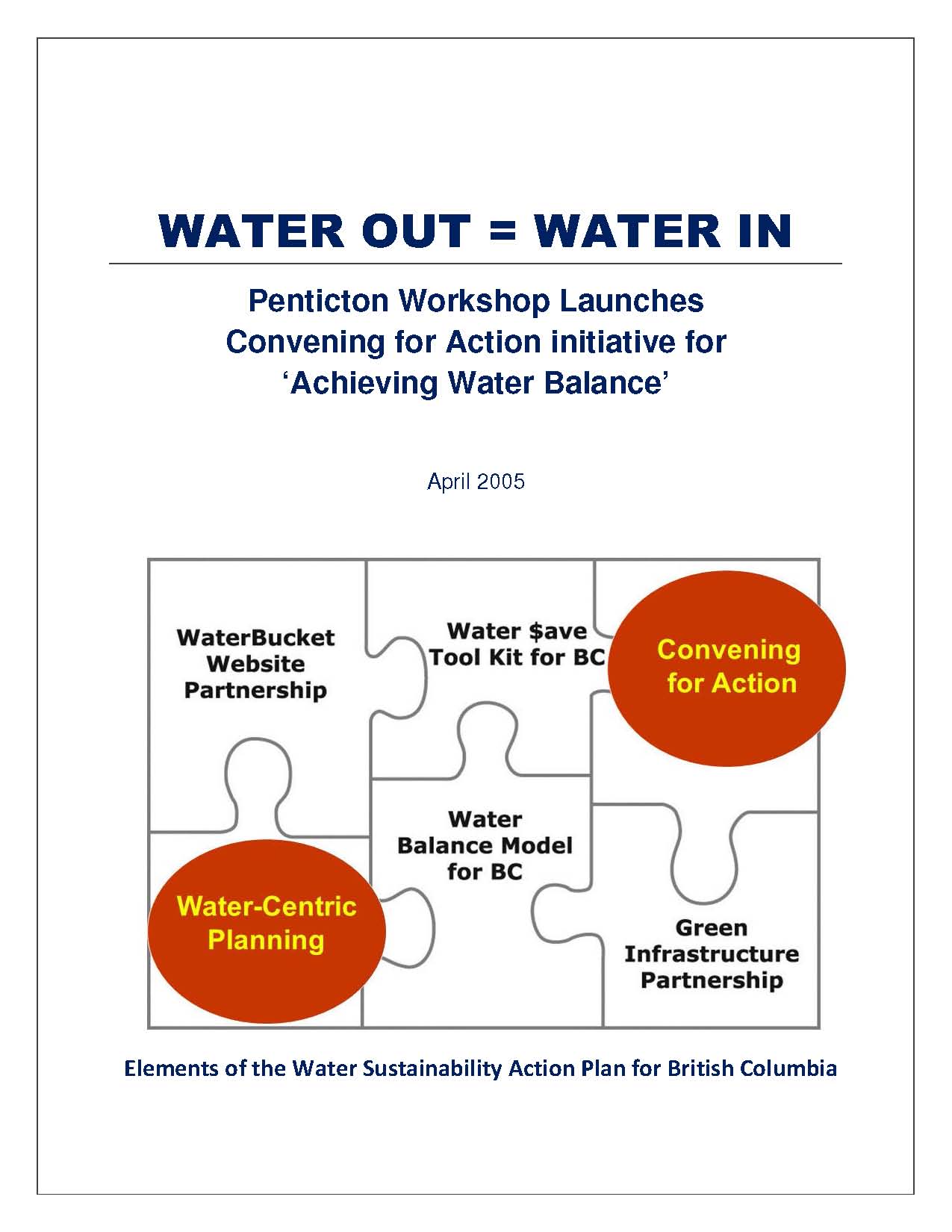CELEBRATING A DECADE OF SUCCESS: “2005 Penticton Achieving Water Balance Workshop” was first regional event held under “Convening for Action in BC” umbrella
10th Anniversary of Achieving Water Balance Workshop
In April 2005, the Achieving Water Balance Workshop was the first regional event organized under the umbrella of Convening for Action in British Columbia, a program element of the Water Sustainability Action Plan. Co-organized by the Province, and held in the Okanagan Valley in the city of Penticton, this technology transfer session introduced fundamental concepts and principles that have influenced land and water practitioners for the past decade. Also, the Minister of Environment formally launched the waterbucket.ca website in conjunction with the workshop.
Looking Back – Looking Forward: Use hindsight to frame what lies ahead
Through the Convening for Action program, the Partnership for Water Sustainability is developing ideas, educating practitioners and building an informed community-of-practice. The 10th anniversary of the milestone 2005 Achieving Water Balance Workshop is an opportunity for reflection and celebration. A decade after this ‘watershed moment’, three members of the workshop team provided their perspectives.
‘Water OUT = Water IN’ Paradigm Portrays Complexity in an Understandable Way
“In 2005, we started a conversation about a water balance way-of-thinking and acting which continues to this day,” states Robert Hicks, Senior Engineer with Metro Vancouver. He co-led the working group which developed the program content to support learning outcomes for Demand Management Strategies – Achieving Water Balance: A Workshop on Dealing with Uncertainty and Managing Risk.
 “We built the workshop program around the Water OUT=Water IN paradigm. The equation is deceptively simple, yet it embodies the basic principles and concepts for dealing with uncertainty and managing risk. It allows us to draw attention to the elements of the water cycle, how we allocate and use water, and make the point that water and land uses are inter-connected.” In 2005, Robert spoke to this theme: Reconciliation of Long-Term Visions with Short-Term Realities: Planning to Live Within Limits
“We built the workshop program around the Water OUT=Water IN paradigm. The equation is deceptively simple, yet it embodies the basic principles and concepts for dealing with uncertainty and managing risk. It allows us to draw attention to the elements of the water cycle, how we allocate and use water, and make the point that water and land uses are inter-connected.” In 2005, Robert spoke to this theme: Reconciliation of Long-Term Visions with Short-Term Realities: Planning to Live Within Limits
“Thinking back to Penticton, a decade later I think the one theme which remains a challenge is for decision advisors (engineers, scientists and planners) to translate issues into language that decision makers can understand. It is about having a common lingo. Scientific qualifications can sound like uncertainty and doubt. Our society operates on ‘yes’ and ‘no’, not on ‘most likely’ or ‘probably’.”
Fabric of Common Understanding Leads to Action
 “It is hard to imagine this work happened only 10 years ago. We know, however, both the waterbucket.ca website and the Convening for Action programs are successes – since the themes around water-centric planning and ‘design with nature’ have become part of the fabric of common understanding and basic foundation of how things need to get done in a region when talking about water,” concludes Oliver Brandes, Co-Director of the POLIS Project at the University of Victoria. In 2005, Oliver delivered a ‘call to action’ on the theme Building Resiliency through a Water Management Continuum.
“It is hard to imagine this work happened only 10 years ago. We know, however, both the waterbucket.ca website and the Convening for Action programs are successes – since the themes around water-centric planning and ‘design with nature’ have become part of the fabric of common understanding and basic foundation of how things need to get done in a region when talking about water,” concludes Oliver Brandes, Co-Director of the POLIS Project at the University of Victoria. In 2005, Oliver delivered a ‘call to action’ on the theme Building Resiliency through a Water Management Continuum.
“These initiatives have been crucial to the infiltration of this new paradigm of practice and understanding. Well done and congratulations to all the hard working souls that have helped this become so.”
Use Hindsight to Frame What Lies Ahead
“Change involves a paradigm shift from an old way of thinking-and-doing to a new way, typically to replace unacceptable outcomes with acceptable ones,” states Erik Karlsen, former Director of Regional Growth Strategies, BC Ministry of Municipal Affairs. At Royal Roads University (2005), he taught a course on Leadership in Sustainable Development. In 2005 at Penticton, Erik elaborated on setting target and objectives:  Change: Challenges & Choices / Responsibilities and Response Abilities
Change: Challenges & Choices / Responsibilities and Response Abilities
“When this occurs some might ask why the old way wasn’t designed to anticipate and prepare for its impacts from the outset? And, more to the point, how do we design and implement new paradigms to achieve more sustainable and resilient outcomes; those which consider and address all interests and are capable of dealing with uncertainties inherent in complex adaptive systems.”
“The Partnership for Water Sustainability provides a leading best practice model for developing and promoting the use of approaches to the management of hydrologic regimes to achieve sustainable and resilient aquatic ecosystems at basin, watershed, drainage and site scales. Through its Convening for Action initiatives the Partnership has pursued a blended paradigm involving a commitment to a green infrastructure through inclusive engagement and shared learning.”
To Learn More:
The OUT = IN equation is variable on both sides. Something to think about is that in mathematics one cannot solve for two variables with a single equation. To download a document that provides more detail, click on Dealing with Uncertainty and Managing Risk: How we can adapt Water Management Systems.







